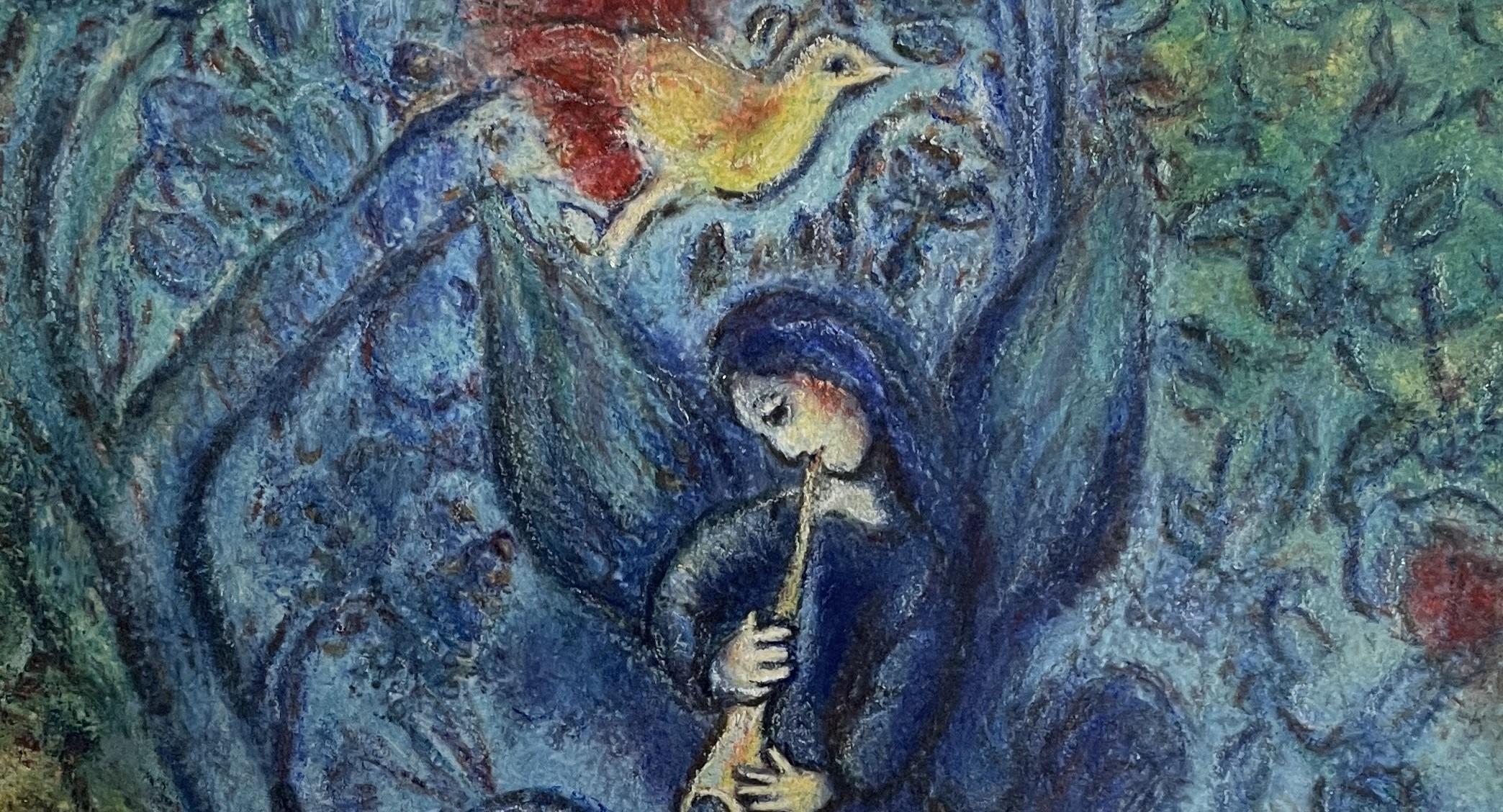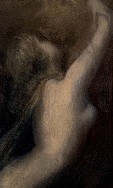日本語-Englishー台灣華語
フレデリック・レイトン「漁師とセイレーン」
セイレーンはギリシャ神話に登場する女の頭と鳥の体を持つとされる海の精である。海の孤島に棲み、近くを船が通りかかると美しい歌声で船乗りを魅了し、深い海の底へ連れ去ってしまうという。セイレーンが登場する物語としては、ホメーロスの「オデュッセイア」の話が有名である。その物語によると、トロイ戦争を終えて故郷に帰還する英雄オデュッセウスは、セイレーンが棲む島を通る時、キルケーの助言に従って水夫たちの耳に蜜蝋を詰め歌が聞こえないようにし、自らは体を帆柱に縛り付けて無事に通過することが出来たという。一説によると、セイレーンは元々麗しい水の妖精であったが、愛の女神アフロディテの怒りを買い、鳥の姿に変えられてしまったという。その後セイレーンは歌の女神に挑んだ歌合戦に敗れ、翼をもぎ取られてしまい人魚になったという。キリスト教では、人魚は虚栄や誘惑を暗示する。日本では人魚が現われるのは暴風雨の前触れであり、不吉なことの前兆であると言われている。
レイトンの「漁師とセイレーン」は、人魚となった海の精が、今正に漁師を海に連れ去ろうとしている場面を描いたものである。オペラ歌手の注文によって描かれたこの絵は、歌声によって魅了された青年が暗示されている。この絵は恋の罠にはまる幸福と呪縛を表している。漁師は両腕をひろげ、キリストの磔刑のように受難を表現していると言われているが、恍惚に浸る漁師は無抵抗である。そこに官能の誘惑を退けようと葛藤する素振りは見えない。男の首に巻きついた女の腕は、二人を離れがたく結びつけている。女と共に海の底に沈んだ男は二度と帰ることはない。沈んだ先にあるのは楽園なのか、はたまた女は男を食らってしまうのか。レイトンが描いたこの絵は、漁師もセイレーンもとりわけ若く美しい。若者は性的誘惑に何の疑いも抱かず、女は本能的に若いうちに相手を籠絡しようとする。セイレーンの腰は極端に折れ曲がり、上半身の魅力を強調している。甘えるように抱きついた女は、自らの勝利を確信しているに違いない。
この絵を描いていると、ロマンティックな気分に侵食され、次第に画面がぼやけてくる。本物のレイトンはずっと鮮明に描いているが、私は男女の境界を曖昧に描きたくなる。レイトンの絵はどれもこれも本当に綺麗である。そのなめらかで美しい画面がレイトンの魅力であるが、同時に歯がゆくもある。レイトンは決して描き込み過ぎない。程よい加減で筆を置く。歳を重ねるごとに男も女も思慮深くなり、全てを投げ打って愛にのめり込むにはためらいを感じてしまうように、過ぎたる深みにはまらない。それは正しくとも、もどかしい。
レイトンは医者の息子として生まれた。父親は息子が跡を継いでくれることを希望したが、息子の才能を信じ、画家になることを支援した。裕福な一家は欧州中を旅行し、レイトンは幅広い見識と教養を身につけることが出来た。レイトンの作品は若くしてヴィクトリア女王に買い上げられる。だれもが美しいと感じる耽美主義的画風を貫き、栄誉に包まれた生涯を送った。ロイヤル・アカデミーの会長に昇りつめ、画家としてはじめて爵位を授与されている。生前自らが設計した邸宅は、今もレイトン・ハウスとして往時の栄華を伝えている。
レイトンの絵には、穏やかで満ち足りた者が醸し出す貴族的美が感じられる。ヴィクトリア朝の礼節を逸脱することなく、気品のある彼の絵は、知的遊戯の中でゆったりと暮らす幸福を私たちに偲ばせてくれる。レイトンの画風はカバネルやジェロームといったフランスのアカデミックな画家たちに引き継がれるが、死後急速にその名は忘れられてしまう。レイトンの絵はあらゆるものが節度をもって美しく描かれ過ぎてしまった故に、永遠の美を保持しえなかったように私には思われる。そこに心を抉るような美を感じることはできない。ただ蜜蝋のように滑らかな絵肌が夢の中に立ち現われるレイトンの絵は、現実から心地よく逃避させてくれる。
The Fisherman and the Siren
Sirens are depicted in Greek mythology as beings with the head of a woman and the body of a bird, dwelling in the sea. They live on solitary islands in the sea and are said to enchant sailors with their beautiful singing voices as ships pass by, luring them to the depths of the ocean. One of the most famous stories featuring sirens is in Homer’s “Odyssey.” According to this tale, the hero Odysseus, returning home from the Trojan War, safely passes the island where the sirens dwell by following Circe’s advice to fill his sailors’ ears with beeswax to block out the song and tying himself to the mast of the ship. There is a theory that sirens were originally beautiful water nymphs who, having incurred the wrath of the love goddess Aphrodite, were transformed into birds. Following their transformation, the sirens lost a singing contest to the Muse and were stripped of their wings, turning into mermaids. In Christianity, mermaids symbolize vanity and temptation. In Japan, the appearance of mermaids is said to be a harbinger of storms and ill omens.
“Fisherman and the Siren” by Leighton depicts a scene where a mermaid, transformed from a sea nymph, is about to take a fisherman into the sea. Commissioned by an opera singer, this painting suggests a young man enchanted by a singing voice, representing the happiness and curse of falling into the trap of love. The fisherman, with his arms wide open in a manner reminiscent of Christ’s crucifixion, is said to express suffering, yet he is blissfully unresistant, showing no struggle against the sensual temptation. The woman’s arms wrapped around the man’s neck bind them inseparably. The man, taken to the sea’s depths by the woman, will never return. Whether a paradise awaits him below or the woman will consume him is unknown. In Leighton’s painting, both the fisherman and the siren are particularly young and beautiful. The youth has no doubts about the sexual allure, and the woman instinctively tries to ensnare her partner while young. The siren’s waist is exaggeratedly bent to emphasize the allure of her upper body, and the woman clinging to him seems assured of her victory.
As I paint this scene, I become enveloped in a romantic mood, and the canvas gradually blurs. While the real Leighton painted with clarity, I find myself wanting to blur the lines between man and woman. All of Leighton’s paintings are truly beautiful, with their smooth and elegant surfaces being part of his charm, yet at times frustratingly so. Leighton never overdoes his details, knowing just when to stop. As men and women age, they become more thoughtful and hesitant to throw themselves into love recklessly, avoiding the pitfalls of too deep an involvement. While this is wise, it can also be frustrating.
Leighton was born the son of a doctor, who hoped his son would follow in his footsteps but supported his talent and decision to become an artist. The wealthy family traveled throughout Europe, allowing Leighton to gain a broad perspective and education. Leighton’s works were purchased by Queen Victoria at a young age. He maintained a beautiful aesthetic style throughout his life, surrounded by honor. He rose to be the president of the Royal Academy and was the first painter to be awarded a peerage. The house he designed and lived in, now called Leighton House, still reflects its former glory. Leighton’s paintings exude an aristocratic beauty emanating from a content and gentle person, reminiscent of the happiness of living leisurely within intellectual play, without deviating from the etiquette of the Victorian era. After his death, Leighton’s style, which was passed on to French academic painters like Cabanel and Jerome, was quickly forgotten. To me, his paintings, where everything is too beautifully and modestly depicted, seem unable to retain eternal beauty. They lack a heart-wrenching beauty, appearing instead like smooth, beeswax surfaces emerging in dreams, allowing for a pleasant escape from reality.
弗雷德里克·雷頓《漁夫與美人魚》
美人魚在希臘神話中是一種擁有女性頭部和鳥類身體的海洋精靈。她們居住在海上的孤島上,當船隻經過時,會用她們美妙的歌聲吸引船上的水手,將他們引誘到深海底下。關於美人魚的故事,荷馬的《奧德賽》最為著名。故事中,結束了特洛伊戰爭,回家的英雄奧德修斯,在經過美人魚居住的島嶼時,按照女巫喀耳刻的建議,讓水手們塞滿耳朵以免聽到歌聲,而他自己則被綁在船的桅杆上,安全通過。有一說法,美人魚原本是美麗的水中仙女,因觸怒了愛神阿佛洛狄特,被變成鳥的形態。之後,美人魚在一場歌唱比賽中敗給了歌神,被撕去翅膀,變成了人魚。在基督教中,人魚象徵虛榮和誘惑。在日本,人魚出現被認為是暴風雨的前兆,是不祥之兆。
雷頓的《漁夫與美人魚》描繪的是一名變成人魚的海洋精靈正試圖將漁夫帶入海中的場景。這幅畫是應一位歌劇歌手的委託而繪製的,隱喻了被歌聲迷住的年輕人。這幅畫象徵著陷入愛情陷阱的幸福和束縛。漁夫雙臂展開,如同基督受難一般,表達了痛苦,但他沉浸在恍惚之中,無力抵抗。不見他掙扎拒絕誘惑的跡象。女性纏繞在男性頸部的手臂,將兩人緊緊相連。與女性一同沉入海底的男性再也無法返回。沉沒之處是樂園還是女性將男性吞噬?雷頓描繪的漁夫和美人魚都極其年輕美麗。年輕人毫無懷疑地面對性的誘惑,而女性本能地試圖在年輕時就迷住對方。美人魚的腰部極度彎曲,強調了上半身的魅力。依偎的女性無疑確信了自己的勝利。
畫這幅畫時,我逐漸被浪漫情緒所侵蝕,畫面逐漸模糊。真正的雷頓畫作始終保持清晰,但我渴望將男女之間的界限描繪得模糊不清。雷頓的每幅畫作都非常美麗,那光滑美麗的畫面是他的魅力所在,但也讓人感到無奈。雷頓從不過度描繪,總是恰到好處地停筆。隨著年齡的增長,男女都變得深思熟慮,對於全心投入愛情感到猶豫,避免陷入過深。這雖然正確,卻也令人感到遺憾。
雷頓出生於醫生家庭,父親希望他能繼承家業,但相信兒子的才華,支持他成為畫家。這個富裕的家庭遊歷歐洲,讓雷頓獲得了廣泛的知識和教育。雷頓的作品很早就被維多利亞女王購買。他貫徹美的主義畫風,享有榮耀的一生,成為皇家學院院長,是首位獲得爵位的畫家。他生前設計的住所,今天仍作為雷頓之家,傳遞著昔日的榮光。雷頓的畫作透露出貴族般的美,不逾越維多利亞時代的禮節,他的畫作讓我們想起在知性遊戲中悠然生活的幸福。雷頓的畫風被如卡巴內爾和傑羅姆等法國學院派畫家繼承,但他去世後迅速被遺忘。雷頓的畫作因為過分講究美而失去了永恆的美感,我無法從中感受到撕心裂肺的美。只有像蜜蠟般光滑的畫面在夢中出現,讓雷頓的畫作成為現實逃避的舒適之所。


